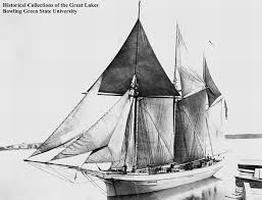
Rouse Simmons
A report from a few years ago. A story well worth retelling.
Today the Christmas Ship is Chicago’s largest all-volunteer charitable support program for inner-city youth and their families at Christmas time. At the turn of the twentieth century, the “Christmas Tree Ship” was a family business. In the mid-1880s, August and his brother Herman Schuenemann moved to Chicago. They were merchants and sailors who made two-thirds of their annual income transporting and selling Christmas trees. August died in November 1898 when the two-masted schooner S. Thal sank in a storm near Glencoe, Illinois. His younger brother Herman continued the family business.
Captain Schuenemann sold his trees directly from the dock by Chicago’s Clark Street Bridge using the slogan, “Christmas Tree Ship: My Prices are the Lowest.” Schuenemann strung electric Christmas lights from the ship’s masts and had a tree atop the main mast. Herman, his wife Barbara and their three daughters also made and sold wreaths, garlands, and other holiday decorations from the ship. The trees were sold for between 50 cents and $1, but Captain Schuenemann, who came to be known as “Captain Santa”, also gave away some of the trees to needy families.
Over the years, Herman Schuenemann commanded various schooners carrying Christmas trees to Chicago, including the George Wrenn, the Bertha Barnes, and the Mary Collins. In 1910, Schuenemann purchased a partial interest in the Rouse Simmons, a 134 three master schooner built in 1868. It was his largest schooner, capable of carrying up to 5,000 trees. When loaded, some said it looked like a floating forest.
The Rouse Simmons was also Captain Schuenemann’s last command. On November 23, 1912, the Rouse Simmons sank in a winter storm in Lake Michigan with the loss of all hands.
For many years, Great Lakes sailors have reported seeing the ghostly image of the Rouse Simmons. Often spotted on moonlit nights, her sails are ripped to tatters and wildly flapping about as if blown by gale winds. Sailors claim that one moment she is there, and the next she has vanished.
In 1924, a wallet, wrapped in oilskin, belonging to Captain Schuenemann was found in a fishing trawler’s net. The wreck of the Rouse Simmons itself was discovered in 1971 by scuba diver Gordon Kent Bellrichard in 172 feet of water in Lake Michigan off Two Rivers, Wisconsin. Many of the trees are still in the ship’s hold.
Chicago’s Christmas Ship continues the tradition begun by Captain Schuenemann of donating trees to needy families. In the last decade, they have distributed over 12,000 trees to the less fortunate.
The Christmas Tree Ship: Captain Herman E. Schuenemann and the Schooner Rouse Simmons

https://www.youtube.com/watch?v=4fcz2T3iba4
Enjoyed this article.
Living on the west coast near the Columbia River, the shipwrecks here are a part of our history stories. This article brings to light a similar lifestyle and the dangers of sailing the Great Lakes.
We think of our west coast as the land of trees, but many of our early loggers and lumber mill owners migrated from the Great Lakes country.
Off-topic but this seems a Captain Spilman-grade marine news item:
https://www.nytimes.com/2018/12/27/world/europe/france-barrel-atlantic-jean-jacques-savin.html?action=click&module=News&pgtype=Homepage
Crossing the Atlantic in a barrel, with tiny windows. Research opportunity for seasick. 🙂